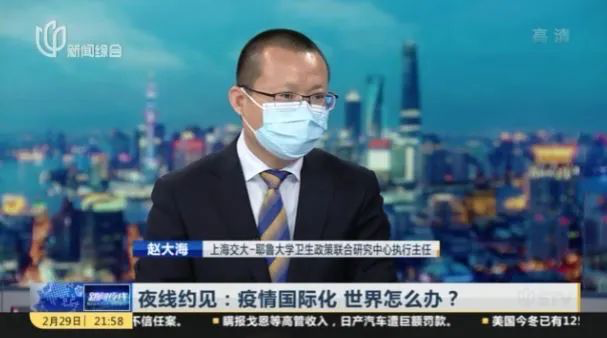上海交大赵大海关于新冠疫情第3次在电视台访谈评论:新冠肺炎疫情国际化,韩日伊意四国面临严峻挑战

上海交通大学国际与公共事务学院博士生导师、上海交通大学-耶鲁大学卫生政策联合研究中心执行主任赵大海近日第三次做客上海电视台演播厅,第四次接受上海电视台的直播采访,也是疫情发生以来第九次在中央电视台或上海电视台进行直播评论。在2020年2月29日晚9点30分上海电视台新闻综合频道的《新闻夜线》节目,赵大海就有关新冠肺炎在国际上的蔓延以及各国的防控措施进行了直播访谈。同期演播室嘉宾是上海社科院国际问题研究所副所长李开盛研究员。此处仅对有关赵大海的访谈摘录如下。

主持人:世界卫生组织总干事谭德赛已经将全世界疫情等级提高到了最高级,联合国秘书长古铁雷斯也称各国疫情的窗口期在收窄,怎么来理解这个收窄,什么时候窗口会关闭?
赵大海:新冠肺炎疫情已波及到了五十多个国家,应该讲已经是全球重大的公共卫生问题,因此确实可以说疫情防控的机会之窗在收窄。对于如何来延长机会之窗,这就需要世界各国采取更为严格的防控措施。唯有如此,才能延长机会之窗。
主持人:韩国和日本的疫情到了什么阶段?
赵大海:韩国的疫情现在非常严峻,形势不容乐观;日本虽然总病例数有九百多例,但扣除来自钻石公主号邮轮的七百多例之外,日本本土的确诊病例数是两百多例,总体防控形势相比较于韩国而言,日本的疫情形势要稍微乐观一些。
主持人:韩国此前经历了MERS疫情,疾控系统得到了改善,为什么这次还是没有控制住疫情?
赵大海:新冠肺炎在韩国最开始,疾控系统是起到了一定的预警作用。新冠肺炎疫情在韩国的防控,疾控系统所起到的作用是有限的;疫情防控还有赖于政府、民众和在野党等的通力配合。韩国疫情之所以防控效果不理想,主要就在于在野党等势力对于政府防控工作的阻挠所导致的。
主持人:韩国为应对疫情出台了一系列防控政策,您觉得这些政策会起到相应的效果吗?
赵大海:韩国政府对本次疫情的防控还是积极主动的,包括出台的这一系列政策等。应该讲,这些政策会起到一定的效果。但是对于韩国疫情而言,目前最严重的地区是大邱和庆尚北道。由于目前没有对这两个地区采取封城等严格措施,这两个地区的居民还会流动到其他地区。因此,如果不对大邱和庆尚北道采取更为严格措施的话,韩国的总体防疫效果还是不容乐观的。
主持人:现在我们来看日本,日本有七百多确诊病例来自于钻石公主号邮轮,您怎么评价日本对邮轮的处置方式?
赵大海:对于钻石公主号在海上进行长时间隔离,这个办法不是特别科学,完全可以有更好的替代方案。如果让乘客在横滨下船就近进行强制隔离的话,钻石公主号游轮上的确诊病例一定比目前的数字要少得多。应该说,相比较于海上隔离的办法,应该有更好的替代方案。
主持人:日本的防控政策会起到怎么样的效果?
赵大海:日本没有采取非常严格的疫情防控措施。此外,日本疫情防控措施的力度也在不断增加,譬如,原先没有提到全国停课,但在2月28号已要求全国中小学停课。日本之所以防控没有特别严格的原因是日本政府对于疫情防控形势的判断是相对乐观的。日本的本土现在是两百多个病例,日本政府感觉防控形势的压力不是特别大;如果未来随着疫情进一步蔓延和吃紧,不排除日本会采取严格措施,或者说疫情防控措施力度增加的可能性。
主持人:现在我们来看一下伊朗,伊朗这次为什么病例会这么多?
赵大海:伊朗的医疗水平是不错的,但伊朗在历史上极少出现重大公共卫生疫情,因此,伊朗不具备应对重大公共卫生疫情的能力和经验。因此,一旦遇到像新冠肺炎这种传播非常强的病毒,就很容易在伊朗传播。另外,也与伊朗民众的生活习惯等因素有关,譬如伊朗居民喜欢聚集和参加公共活动,这也便于病毒的传播。
主持人:意大利的疫情也比较严重,您怎么看意大利的疫情?
赵大海:意大利政府对疫情防控非常重视,采取的措施也是非常果断。在比较早的时候,就对北部的十余个市镇就进行了封城,不经过许可是不可以随意进出所封闭的地区;意大利政府对违反者采取非常严格的惩罚,如监禁或经济罚款等。总体而言,意大利整个防控措施还是非常到位的,当然形势也是非常严峻。
主持人:通过本次新冠肺炎疫情,您认为有没有可能建立起全球共同应对传染病的合作机制?
赵大海:对于像新冠病毒这种传染性非常强的传染病而言,确实是需要建立起全球联防联控的应对机制。但在实践当中,各个国家还是考虑到自己国家的政治经济社会等各方面的因素,建立起全球联防联控的传染病应对机制还有很长的路要走。
供稿单位:国际与公共事务学院
日期:2020年03月01日
Dahai Zhao' 3th comments on TV during the Pandemic: COVID-19 is Spreading Globally, South Korea, Japan, Iran and Italy Confront Severe Challenges
At 9:30 pm on February 29, 2020, the "News Night" program of Shanghai TV News Integrated Channel, Zhao Dahai conducted live interviews on the international spread of COVID-19 and preventive measures in various countries. During the same period, the guests in the studio were researcher Li Kaisheng, deputy director of the Institute of International Studies, Shanghai Academy of Social Sciences. Here is an excerpt from an interview with Zhao Dahai.
Anchor: WHO Director-General Tedros Adhanom Ghebreyesus has announced the world's epidemic to the highest level. The Secretary-General of the United Nations also said that the window of the epidemic is narrowing. How to understand this narrowing and when will the window close?
Zhao: COVID-19 epidemic has spread to more than 50 countries. It should be said that it is already a major public health problem globally. Therefore, it can be said that the window of opportunity for epidemic prevention and control is narrowing. As for how to extend the window of opportunity, this requires countries around the world to take stricter control measures. Only in this way can the window of opportunity be extended.
Anchor: At what stage are the situation in South Korea and Japan?
Zhao: The situation in South Korea is serious and not optimistic. Although the total number of cases in Japan is more than 900, excluding the more than 700 cases from the Diamond Princess, the number of confirmed cases in Japan is more than 200. The overall situation of prevention and control in Japan is slightly more optimistic than that in South Korea.
Anchor: South Korea experienced the MERS outbreak before, and the CDC has been improved. Why is the outbreak still not contained this time?
Zhao: At the beginning of COVID-19 in South Korea, the CDC played a certain early warning role. In South Korea, CDC plays a limited role in the prevention and control of COVID-19. It also depends on the cooperation of the government, public and party out of office. The main reason for the unsatisfactory prevention and control effect in South Korea is that the party out of office and other forces obstructed the prevention and control work of the government.
Anchor: South Korea has issued a series of prevention and control policies in response to the epidemic. Do you think these policies will have corresponding effects?
Zhao: The South Korean government is active in preventing and controlling this epidemic, including this series of policies. It should be said that these policies will have a certain effect. But for the South Korean epidemic, the worst areas are Daegu and Gyeongsangbuk-do. Since strict measures such as closing the city have not been adopted, residents in these two areas will also migrate to other areas. Therefore, if more stringent measures are not taken against Daegu and Gyeongsangbuk-do, the overall epidemic prevention effect in South Korea is not optimistic.
Anchor: Now let's look at Japan. There are more than 700 confirmed cases in Japan from the Diamond Princess. How do you evaluate Japan's treatment of cruise ships?
Zhao: This is not particularly scientific for the Princess Diamond's long-term isolation at sea, and there can be better alternatives. If passengers are to be disembarked from Yokohama for quarantine, the number of confirmed cases on the Diamond Princess must be much less than the current figure. It should be said that there were better alternatives.
Anchor: What effect will Japan's prevention and control policies have?
Zhao: Japan has not adopted very strict epidemic prevention and control measures. In addition, the intensity of Japan ’s epidemic prevention and control measures is also increasing. For example, there was no class suspension in the country, but on February 28, primary and middle schools in the country were requested to be suspended. The reason why Japan's prevention and control is not particularly strict is that the Japanese government's judgment on the situation of epidemic prevention and control is relatively optimistic. Japan is now more than two hundred cases, and the Japanese government feels that the pressure on the prevention and control situation is not particularly great. In the future, if the outbreak spreads further and gets tighter, it is possible that Japan will take strict measures, or increase the intensity of epidemic prevention and control measures.
Anchor: Now let's look at Iran, why is there so many cases in Iran this time?
Zhao: Iran's medical level is good. Iran has rarely experienced major public health epidemics in history. Therefore, Iran does not have the ability and experience to respond to major public health epidemics. Therefore, once they encounter a very strong virus such as COVID-19, it can easily spread in Iran. In addition, it is also related to factors such as the lifestyle of the Iranian population. For example, Iranian residents like to gather and participate in public activities, which also facilitates the spread of the virus.
Anchor: The epidemic situation in Italy is also serious. What do you think of the epidemic situation in Italy?
Zhao: The Italian government attaches great importance to the prevention and control of the epidemic, and the measures taken are also very decisive. Earlier, more than a dozen cities and towns in the north were closed. It is not allowed to enter and leave the closed area without permission. Italian government imposes very strict punishments on violators, such as imprisonment or financial fines. Overall, Italy's overall prevention and control measures are still in place, of course, the situation is also very grim.
Anchor: Through this COVID-19, do you think it is possible to establish a global cooperation mechanism to jointly respond to infectious diseases?
Zhao: For a highly infectious disease such as COVID-19, it is indeed necessary to establish a global joint prevention and control response mechanism. However, in practice, various countries still take into account their own political, economic, and social factors, and there is still a long way to go to establish an infectious disease response mechanism for global joint prevention and control.
Contributor: SJTU School of International and Public Affairs
Data: March 1, 2020

